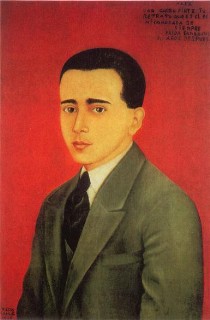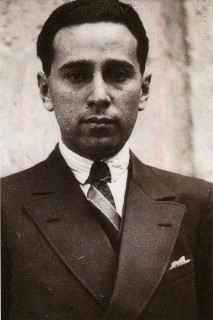Portrait
of
Alejandro Gómez Arias
1928
This painting is
a portrait of Frida's boyfriend Alejandro Arias. It is painted in a conventional
portrait style similar to that of a photograph…a sharp contrast to
the Renaissance style of her previous portraits.
The legend in the upper right corner of the painting reads: "Alex,
with affection I painted your portrait, that he is one of my comrades
forever, Frida Kahlo, 30 years later".
In 1922, Frida began classes at the National Prep School in Mexico City.
There she met and fell in love with Alejandro Gómez Arias. For
three years they were inseparable. Alex, as Frida called him, was with
her on that rainy September afternoon in 1925 when the bus they were riding
was struck by a trolley. Alejandro was not seriously injured and it was
he who convinced the doctors at the Red Cross Hospital to attend to Frida
after they had left her thinking she was too seriously injured to ever
survive. Without his persistence Frida probably would have died.
While recovering from the accident, Frida wrote countless letters to Alex.
In her letters she complained about the pain and about being bedridden,
asking him sometimes, "what is going to happen in 30 years",
or "how am I going to be when I am 30".
Frida and Alex separated in June of 1928 and Frida quickly turned her
attention towards Diego Rivera.
This painting's status was "whereabouts unknown" for several years but, through his heirs, surfaced again following the death of Gómez Arias in 1990. It was on display at the 2005 Kahlo exhibit at the Tate Modern in London and again at the Palace of Fine Arts Museum in Mexico City for the 100th anniversary exhibit. Rachel Tibol, a well known Mexican art critic and author of several Kahlo books, viewed the painting at the exhibit in Mexico City and declared it a "fake". However, in a 1950 interview by Olga Campos, Frida described the painting which confirmed it's authenticity.

Oil
on wood
24" x 16"
Private Collection, Mexico
Óleo sobre madera
61,5 x 41 cm.
Colección privada, México

Photograph
of Alejandro
(Foto de Alejandro)
Retrato de
Alejandro Gómez Arias
1928
Este retrato es un retrato del novio de Frida, Alejandro Arias. Estaba pintado en el estilo de un retrato convencional, similar al de una fotografía…un marcado contraste con el estilo Renacentista de sus previos retratos.
La inscripción en la esquina superior derecha de la pintura dice: "Alex, con cariño pinté tu retrato, el es uno de mis camaradas para siempre, Frida Kahlo, 30 años mas tarde".
En 1922, Frida empezó las clases en la Escuela Nacional Preparatoria en la ciudad de México. Allí, conoció y se enamoro de Alejandro Gómez Arias. Durante tres años fueron inseparables. Alex, como Frida le llamaba, estaba con ella en la tarde lluviosa de septiembre de 1925, cuando el autobús en el que iban montados choco con un tranvía. Alejandro no sufrió heridas serias y el fue quién convenció a los doctores en el Hospital de la Cruz Roja de que atendieran a Frida, cuando ya se marchaban pensando que las heridas que ella sufría eran demasiado serias para sobrevivir y no había nada que hacer. Sin su persistencia, Frida probablemente hubiera muerto.
Mientras se recuperaba del accidente, Frida le envió innumerables cartas a Alex. En sus cartas, se quejaba del dolor y de estar en cama, preguntándole algunas veces "que va a pasar dentro de 30 años" o "como voy a ser cuando tenga 30 años"
Frida y Alex se separaron en Junio de 1928 y Frida pronto se dedicó a Diego Rivera.
Esta pintura estuvo en "paradero desconocido" durante varios años pero, a través de sus herederos, apareció de nuevo después de la muerte de Gómez Arias en 1990. Se exhibió durante la exposición Kahlo del 2005 en el museo Tate Modern de Londres y otra vez en 2007 en el Palacio de Bellas Artes en la ciudad de México, para la exposición del centenario de Frida. Raquel Tibol, una crítica de arte Mexicana y autora de varios libros acerca de Kahlo, vio la pintura en la exposición y la declaró "falsa". Sin embargo, en una entrevista de 1950 por Olga Campos, Frida describió la pintura que confirmó su autenticidad.